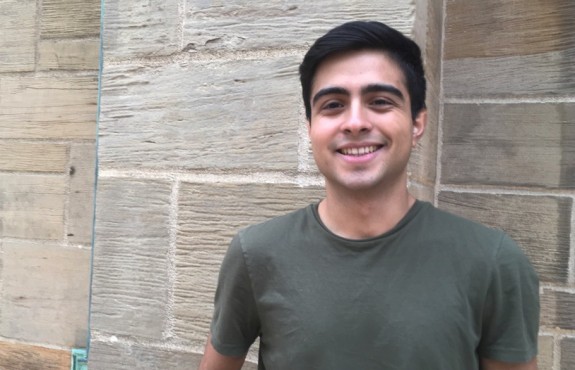
Students as Educators in Kenyon’s Apprentice Teacher Program

There’s a lot more to taking a foreign language at Kenyon than one might think. Students involved in the Kenyon Intensive Language Model attend classes with a Master Teacher, but they also have the opportunity to practice their skills in a more informal setting with an Apprentice Teacher. That’s where Eduardo Vargas ‘18 comes in.
Eduardo, a Neuroscience and Spanish Literature major from Claremont, CA, decided to become an Apprentice Teacher (AT) to relate with others in a meaningful way. “We’re all students, we’re just learning in different capacities… I felt like [being an AT] was a good opportunity to make myself visible on campus.” Like many ATs, apprentice teaching is personal for Eduardo: “I liked being able to share the way that I understand language, and the way that it’s tied to my culture and background.”
Eduardo was drawn primarily to the peer environment of Apprentice Teaching. Because a fellow Kenyon student is leading the class, students are usually more open to applying their foreign language skills to real life. “The best way to get them to use the target content is to incorporate what they’ve learned into ways they can express part of their personality, part of their day, things like that,” Eduardo says. A typical AT class has only six students, meaning it’s a perfect environment for individualized expression and for practicing pronunciation, vocabulary, and verb conjugation.
Although AT classes are required just like classes with professors, the peer experience leaves room for an AT to be flexible and relatable in class content. “Sometimes we play games, sometimes I bring candy from Mexico, we watch music videos, we look at memes and tweets… as long as it contributes to learning the content, all of those are fair game,” Eduardo says. The emphasis in AT classes is on practicing the language, not necessarily getting everything correct. To reduce the pressure that some students might feel in classes taught by a faculty member, ATs encourage the use of the vernacular in their classes. “It’s not the same dynamic that exists between a student and a professor… it’s more casual and more comfortable,” Eduardo says.
ATs work with their assigned Master Teacher (MT), a professor of the target language, to compile an engaging, productive lesson plan for each class. Based on what students are working on in their MT class, an AT puts together activities and exercises to supplement that material. It’s not just the students, though, who learn from the AT class model. “Usually I learn as much as they do… I’m relearning my own language, and they’re learning a new language.”
Just as the AT program shapes students into more confident speakers, it also helps the ATs themselves develop as learners and as teachers. “There’s a lot of room for growth,” says Eduardo. “You learn a lot about yourself… how you work with others, how you engage with academic material.”
ATs can start out as fluent native speakers of a target language or as students with intermediate classes under their belt. There’s a good deal to be learned on the job, Eduardo says, which is why support from more experienced ATs and from the Modern Languages and Literatures department is readily available. “There’s an opportunity for mentoring at the beginning,” Eduardo says. “You don’t go into the first day super nervous.”
In addition to gaining practical experience as an educator and with teaching the target language, ATs gain skills that can be applied to a career in any subject. “It takes a lot of initiative… having that classroom experience is really valuable,” Eduardo says. Leadership, public speaking, group management, and communication skills also follow an AT from Kenyon to the global community beyond.
The Foreign Language department looks for applicants who aren’t just confident speakers. Candidates should be able to communicate in the target language with clarity, but an advanced vocabulary isn’t a requirement. After his time on the job, Eduardo characterizes a good AT as “a confident, flexible problem solver with an open mind.”
For those who think they might fit this description, the application to become an AT is live on Symplicity until March 1st.
by Amelia Yeager '20